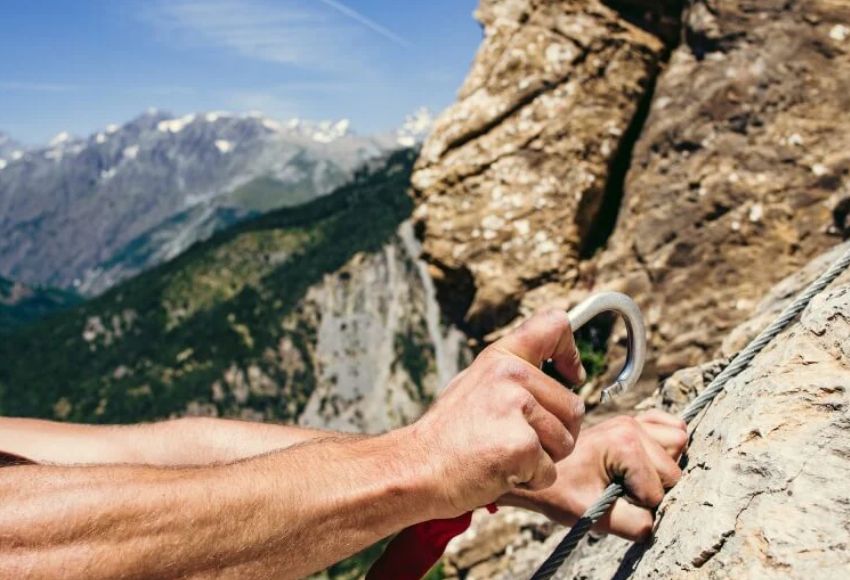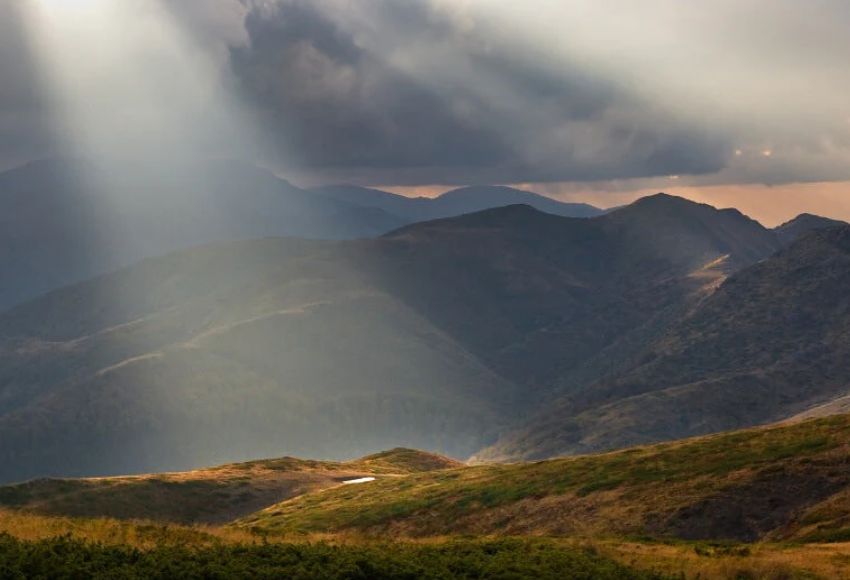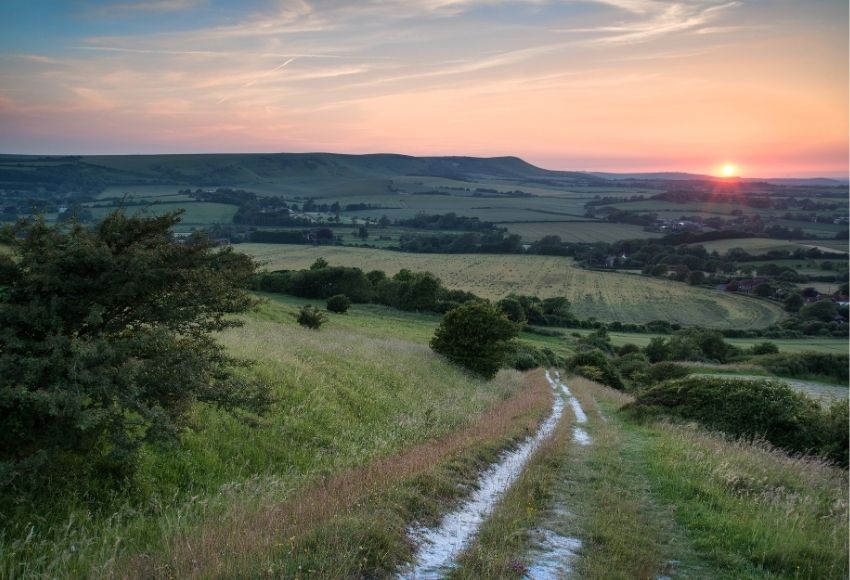First steps on secured roads – safely, confidently and with respect
Via ferratas. Or secured routes in the mountains that combine the beauty of the mountains with vertical excitement. They are more accessible than sport climbing, but still unforgiving of mistakes.
Attaching yourself to a steel cable will transport you to a world where you are 20 meters higher than usual. And perhaps where you are a bit stronger, braver and more present.
It's not climbing. But it's not hiking either.
Here's everything you need to know before you snap a carabiner for the first time.

What is via ferrata?
"Via ferrata" in Italian means "iron road" . It is a secured route in rocky terrain , equipped with:
- steel cable (fixed),
- iron steps, pegs, ladders, bridges,
- sometimes even elements such as overhangs or rope crossings.
It allows access even to those without climbing experience - but it requires strength, endurance and, above all, respect for height and one's own safety.
What do you feel when you're standing under a rock?
You can have the perfect gear, all the articles loaded, but once you’re standing at the foot of a via ferrata, it usually starts in your head. It’s not necessarily fear – more of a mix of anticipation, slight uncertainty and a huge “what if.” What if I don’t make it? What if my legs give out? What if the height overwhelms me?
This nervousness is normal. Absolutely. And honestly – if you don’t feel it, maybe you haven’t fully realized what awaits you yet. Because a ferrata is not an ordinary hike. It’s a moment when you truly surrender to the space, the height, the steel rope and most importantly – to yourself.
You might not know where to put your hands for the first few steps. You’ll feel awkward. You’ll check to make sure both carabiners are properly fastened, even though you know. And that’s a good thing. Because that slight caution, that slowing down, that concentration – that keeps you in the present. And via ferrata is about the present more than anything else. Here and now. One carabiner, one step, one decision.
And then, with each meter higher, you find that it works. That you find a rhythm. That your body starts to cooperate. That the view starts to triumph over the height. And when you then turn back down – to the place where you stood a moment ago and wondered if you could even do it – you feel something that is hard to describe.
A confidence that isn't loud. It's calm. Firm. Adult. And in that moment you'll understand why people keep coming back to via ferratas. Not just for the adrenaline. But for who they become on them.
How to prepare for your first altitude
The fear you feel when you first look down from a vertical section is not a failure. It is your body’s normal reaction to an unfamiliar height. The first deep breath, the first glimpse into space… and then that familiar tightness in your stomach. This is normal fear – and it is what protects you. It helps you stay alert, slow down and focus. Don’t be afraid of fear – learn to walk alongside it.
It helps a lot to consciously work with your breath. When you feel like the height is “closing” you, stop, take three deep breaths through your nose, exhale through your mouth, calmly and loudly. Relax your shoulders. Relax your jaw. And then decide whether to continue – or just exhale and hang for a while. Rest is not a loss. On the contrary – the more you can afford it, the more you will enjoy the via ferrata.
From a technical point of view, remember one fundamental rule: watch your center of gravity. Your body should be as close to the rock as possible. Don't pull on your hands unnecessarily - rely more on your legs. If you stand "to the right of the rope, but with your left hip sticking out into space", you will be unstable and will use up much more energy. Body to the rock, look up, work calmly.

What should you know before you even set off?
1. Basic safety rules
- Never completely unhook yourself from the rope. Always have at least one carabiner attached.
- Do not climb directly under another person. A falling rock or a climber's fall could be fatal to you.
- Don't climb in a storm or rain. Steel conducts electricity. Wet rock is slippery.
- Beware of fatigue. You can't "turn back" halfway through.
2. The right equipment is essential
No sane person will let you on a via ferrata without it. Literally.
What do you need for a via ferrata?
|
Thing |
Why is it important? |
|
Ferrata set (fall absorber / brake) |
Two carabiners + flexible system that absorbs the fall (brake) |
|
Sedentary work |
Secure attachment to the set |
|
Helmet |
Protection against falling stones (or heads) |
|
Glove |
Against rope abrasion, better grip |
|
Sturdy shoes |
Ideally via ferrata or trekking shoes with good soles |
|
Indent (optional) |
For beginners on more difficult sections, or for children |
💬 Don't skimp on equipment. A fall arrester for 1500 CZK can save your life.
Via ferrata difficulty scale
In Europe, two scales are most commonly used:
Austrian (A–E):
To begin with, it is important to know that the difficulty of a via ferrata is not always uniform. A via ferrata route does not mean that its entire course corresponds to one level of difficulty. On the contrary – most via ferratas are a combination of sections of varying difficulty.
For example, a via ferrata marked “C/D” may be 80% moderate (grade C) but contain a short, technically challenging section at grade D – such as an overhang or exposed traverse. The same applies to combinations B/C, D/E, etc.
Therefore, it is important:
- Read the entire route description (not just the letter)
- Find out where the hardest spot is (e.g. right at the beginning, or after an hour of climbing)
- Consider whether you have the strength and experience to handle this most difficult point.
As a rule, a via ferrata is rated by its most difficult point. But the overall impression depends on the length, elevation, exposure and retreat options.
A: Light, touristy - comfortable with a little iron
Via ferrata sections of this difficulty are more or less hiking trails that are only lightly secured with a steel cable to help in more challenging places - for example, when crossing a footbridge or when climbing a gentle rock. The terrain is mainly pedestrian, leading through the forest or along rocky paths, and can be mastered even by children or complete beginners. You hardly need your hands, everything can be covered with your feet. Ideal if you want to "feel" the via ferratas first without stress and heights.
- Example: Zinodl
B: Slightly exposed - Easy challenge for new adventurers
With the Béčko ferrata sections, you are entering the real vertical world – but still without the extreme. Expect occasional climbing on pegs, sloping rocks, a bit of height and the need to hold on to the rope with your hands. It is still suitable for beginners, but your sure footing and head for heights are tested. If you are athletic and do not suffer from a significant fear of heights, the “Béčko” can be an ideal start.
- Example: Drachenwand (AT)
C: Athletically demanding, requires strength – A true via ferrata ride
Grade C via ferrata sections are full-fledged sporting experiences that require the involvement of the whole body. Expect longer vertical sections, more powerful passages and fewer places to rest. Your hands will be working, your head will be alert and the height will be felt even in your knees. This is the ideal level for those who have already done their first ferratas and want to move on.
- Example: Double Tower in Spálený žleb (CZ)
D: Technically difficult, overhangs, height - Test of both physical and mental strength
This is where the real challenge comes in. Grade D via ferrata sections tend to be steep, long, and often lead over overhangs, rope crossings, or very exposed walls. You need excellent fitness, steady hands, and a strong head – because retreat is often impossible, and an overextended ascent will come back cruelly. This level of difficulty is only for people who know what they are getting into and have respect for the terrain.
- Example: King's Yodeler (AT)
E: Extreme, physically and mentally demanding - only for the more experienced
Grade E via ferrata sections are not for most people. They are extremely demanding routes with minimal steps, long overhangs, high exposure and require maximum strength and mental endurance. The protection is perfect, but if you make a mistake, you will learn a hard lesson. These routes are only intended for those who have done a number of more difficult via ferratas and know how their body and psyche work under stress and altitude.
- Example: Skywalk on Dachstein (AT)
F – Ultra-Extreme for the elite only
Grade F via ferratas are not on the original Austrian scale (A–E), but in recent years they have been used for the most extreme secured routes in the world – those that:
- They lead over long overhangs without rest,
- have a minimum number of footrests,
- require climbing technique and endurance at the level of a sports climber,
- They are physically and mentally at their absolute limit.
These routes are often not intended for ordinary tourists or advanced via ferrata climbers. They require training, specialized equipment, knowledge of rope work, and experience with difficult D/E grade via ferratas.
Ferrata F is a zone for professionals or highly trained enthusiasts. It is not a challenge to "try" - it is a top discipline.
Hüsler (1–6):
- 1 – easy hike
- 6 – pure vertical for experts
📌 For starters, we recommend: A–B or 1–2.

How to choose your first via ferrata?
Consider:
- your fitness and relationship to heights
- possibility of escape (e.g. escape route halfway)
- accessibility (cable car, marked access route)
- length of the via ferrata (some last 20 minutes, others 4 hours)
🧭 Go on your first via ferrata with someone more experienced or with a guide.
LIST of recommended via ferratas for beginners (from the app)
Practical tips from the field
- Don't carry a heavy backpack. The extra weight makes climbing more difficult and reduces stability.
- The route ends with the ascent, not the approach. Don't forget the descent route.
- Some ferratas require payment. Take some change or a mobile phone with an app.
- In summer, it's better to go early. It's hot and crowded in the afternoon.
- Don't underestimate drinks and sugars. Via ferratas can be demanding and require a lot of energy!
The most common mistakes of beginners
- Renting poor quality equipment without inspection
- Insufficient physical preparation – the arm will stop working in the middle of the wall
- They forget to primarily use their legs when climbing - this will relieve the strain on your arms and you don't have to worry about them giving up on you in the middle of the via ferrata.
- Too large gaps between people – poor belaying
- Selfie in the worst place
- Lack of information about the length of the route and descent
And what do via ferratas really give you?
- Self-confidence: you will overcome the height, fear, pain in your hands – and you will reach the top.
- Presence: every click of the carabiner is a mindfulness exercise.
- Fitness: you will strengthen your entire body without going to the gym.
- Views: via ferratas often lead to places where the average tourist cannot reach.
- Experiences: that will make your forearm hurt the next day – but will stay in your head forever.
Via ferratas are not extreme – if you take them seriously
You don't have to be a climber to experience the vertical world. But you do have to be prepared, informed, and humble. Safety on a via ferrata is no accident. It's a combination of the right equipment, decision-making, and respect for the terrain.
Attach a carabiner – and experience the world from a different perspective.





Leave a comment
All comments are moderated before being published.
This site is protected by hCaptcha and the hCaptcha Privacy Policy and Terms of Service apply.